The 'Gokhran Collection' of OptoClones™ from the Moscow Kremlin Diamond Fund (Pt. #2)
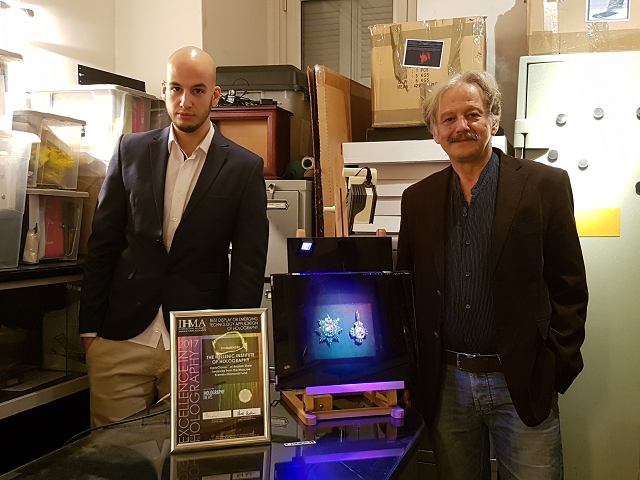 K. Sarakinos & A. SarakinosContrary to 2015 when the last 'Best of Year' prize was accorded, no such award was granted at the latest annual awards of the Int'l Hologram Manufacturers Association (IHMA) which was hosted in Barcelona during the Holography Conference 2017 (click to see a review with photos from the conference and the ceremony). However, this latest occasion attracted a record number of candidate projects and therefore the award to the Hellenic Institute of Holography (HiH) of a Commendation for Best Display Application for OptoClones™ of Russian State Treasures from the Moscow Kremlin Diamond Fund made the team of our holographers [Andreas Sarakinos (scientific director of HiH and head of holography team) and Kostas Sarakinos (assistant)] extremely proud. Alkis Lembessis, HiH director, was there for the collection of the prize on behalf of all participants and contributors to this project such as ITMO University of St. Petersburg (click here to watch an exclusive 1 min video from the 'Oscars of Holography' award ceremony).
K. Sarakinos & A. SarakinosContrary to 2015 when the last 'Best of Year' prize was accorded, no such award was granted at the latest annual awards of the Int'l Hologram Manufacturers Association (IHMA) which was hosted in Barcelona during the Holography Conference 2017 (click to see a review with photos from the conference and the ceremony). However, this latest occasion attracted a record number of candidate projects and therefore the award to the Hellenic Institute of Holography (HiH) of a Commendation for Best Display Application for OptoClones™ of Russian State Treasures from the Moscow Kremlin Diamond Fund made the team of our holographers [Andreas Sarakinos (scientific director of HiH and head of holography team) and Kostas Sarakinos (assistant)] extremely proud. Alkis Lembessis, HiH director, was there for the collection of the prize on behalf of all participants and contributors to this project such as ITMO University of St. Petersburg (click here to watch an exclusive 1 min video from the 'Oscars of Holography' award ceremony).
In November 2017, for the celebration of the 50th Anniversary since the opening of the Moscow Kremlin Diamond Fund, the Russian government (Min. of Finance) decided to impress the public with the modern use of another advanced technological Russian invention, that of Reflection Display Holography. Τhe Hellenic Institute of Holography (HiH), as part of its collaboration agreement with ITMO University of St. Petersburg, responded to the open public tender call and recorded 11 invaluable historical artworks into ...
OptoClone of the Esclavage Bow (1764, Gokhran) ... equally unique OptoClones™ given the demanding technical difficulties in their holographic recording. For those who have the opportunity to eye-witness from close even one of these holographic clones of latest generation, these are deemed maybe the best in display holography to this date. To the degree that the chronically sceptical and usually economical in compliments 'patriarch' of (commercial) holography David Tidmarsh unhesitantly commented 'this is the best hologram I have seen; it had me fooled and no hologram has ever done that before!

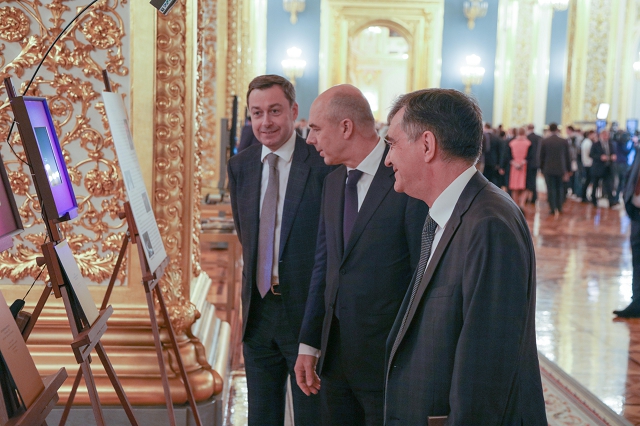 A.Trachuk, A.Siluanov, A.Jurin A.Trachuk, A.Siluanov, A.Jurin |
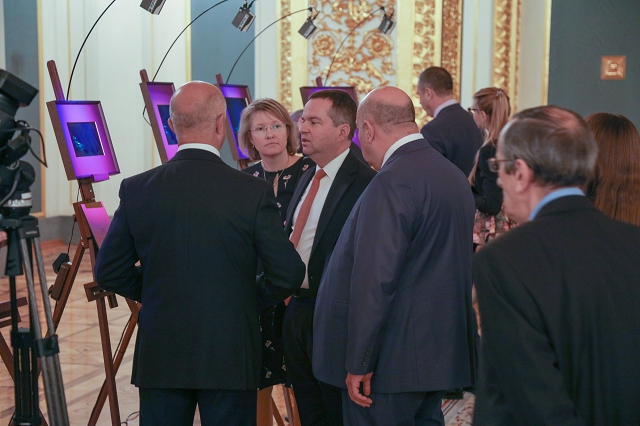 A.Moiseev (Dep.MinFin),foreign guests A.Moiseev (Dep.MinFin),foreign guests |
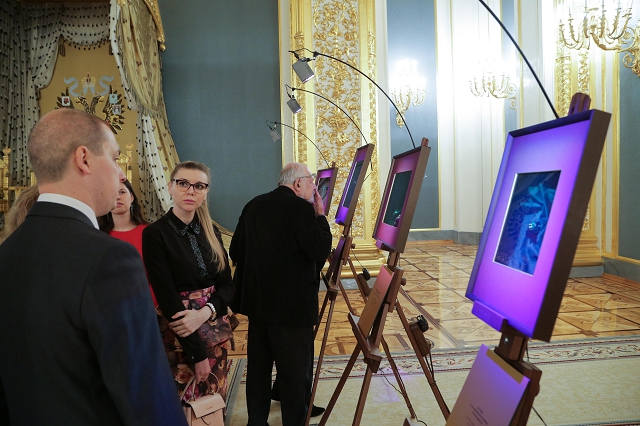 V. Rozhkov (GOKHRAN) with press V. Rozhkov (GOKHRAN) with press |
Maybe not so, if the impulsive reactions of the invitees to the special ceremony on the 50th anniversary of the inauguration of the Moscow Diamond Fund at the Central Palace of Moscow Kremlin on Novemebr 16th, 2017 are taken into consideration. And should the public and private comments of Russian officials and members of government be somewhat presumed, the intense interest of foreign guests from corresponding museums in Stockholm, London, Copenhagen, Dresden, Antwerp and Isfahan surely can not be taken for granted.
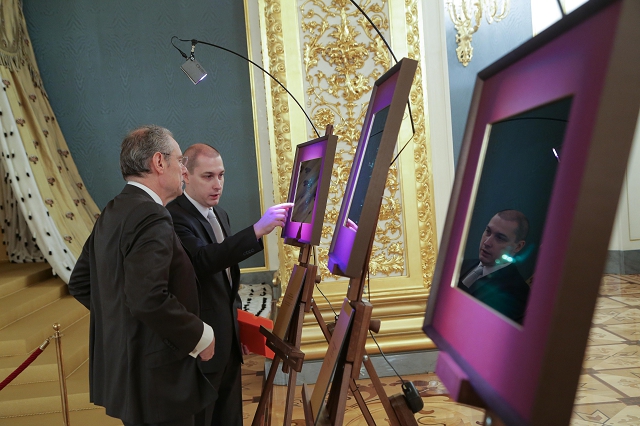 S. Fischler (B), V. Rozhkov (Ru) S. Fischler (B), V. Rozhkov (Ru) |
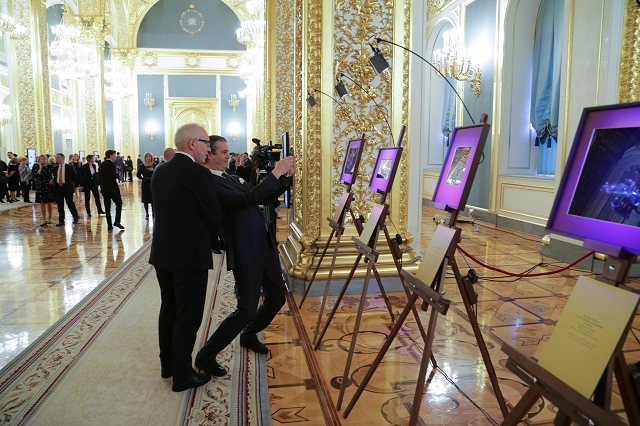 S. Larsson (S), M.Gerle (S) S. Larsson (S), M.Gerle (S) |
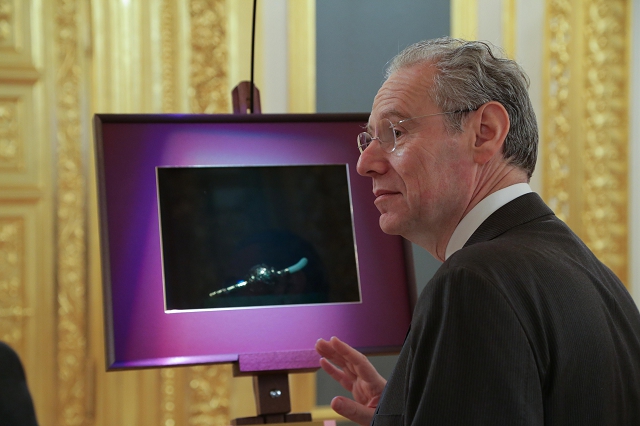 S. Fischler (B) S. Fischler (B) |
Clearly, the epitome of such remarks are the comments of the Premier Minister of the Russian Federation Dmitry Medvedev publicly declaring on-camera that "these OptoClones must travel within the country in order to be witnessed by all those who have no physical access to the original objects at the Kremlin Diamond Fund" (click on the adjacent subtitled short video clip from Russian TV in order to watch the relevant excerpts) whereas his humanly spontaneous hand-gesture to tactually assess the depth of the OptoClones is perhaps the highest reward for our efforts.
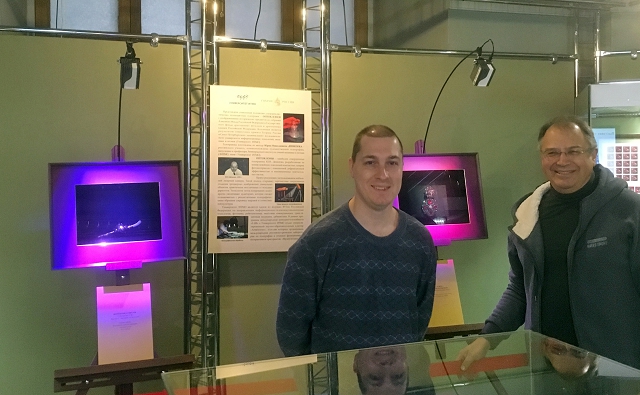
The future plans of the organizers for this Gokhran Collection of Optoclones are exciting enough and allow reasonable optimism for the prospects of Display Holography for museums. Naturally, you will be the first to learn about as soon as they begin to take shape. Watch this space!
The accumulated expertise of HiH in on-site holographic documentation of museum artworks of various types, already from 4 museums of world caliber and reputation (Athens and Thessaloniki Byzantine, Fabergé Museum of St. Petersburg and Diamond Fund of Russia), is unique by all standards and the best guarantee for a successful tangible end-result.
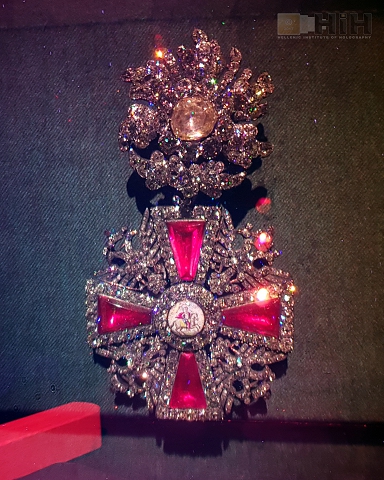 OptoClone of St.Nevsky Order (1770, Gokhran)The ultra-realistic OptoClones are recorded on special panchromatic photo-sensitive high-resolution glass plates of fine grain, in a way resembling the early days of conventional photography. During holographic recording, HiH transports and installs its proprietary equipment at the Museum premises, where the selected artefacts are positioned on a special anti-vibration basis by the responsible conservators. The objects are exposed for few seconds in laser light of very low intensity passing through the holographic plate, on which the reflected light wavefront is recorded. The exposed plate is then developed, processed and dried.
OptoClone of St.Nevsky Order (1770, Gokhran)The ultra-realistic OptoClones are recorded on special panchromatic photo-sensitive high-resolution glass plates of fine grain, in a way resembling the early days of conventional photography. During holographic recording, HiH transports and installs its proprietary equipment at the Museum premises, where the selected artefacts are positioned on a special anti-vibration basis by the responsible conservators. The objects are exposed for few seconds in laser light of very low intensity passing through the holographic plate, on which the reflected light wavefront is recorded. The exposed plate is then developed, processed and dried.
The unique analogue hologram derived in this manner, when properly lit, represents the original object in 1:1 scale and in every detail, at such a degree of fidelity that cannot be differentiated by the human brain. As a result, the HiH OptoClones can attract the attention not only of conventional technologically advanced viewers but also of visitors with a broader contemporary perspective in their cultural interests.
Naturally, photographs of these holograms (such as those shown on this page) cannot communicate either the real chromatic impression nor the analytical detail that only 'live' viewing can offer. OptoClones of this type are useful not only for the virtual exhibition of works of art but -more importantly- for the recording and documentation of their state before/after restoration, before/after temporary loans, for their safe comparative analysis and study, for educational purposes and many other practical Museum applications.
| Next > |
|---|



